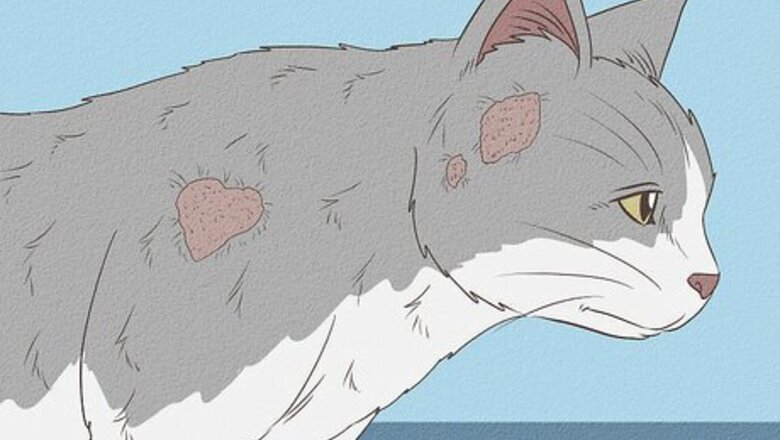
views
Identifying Ringworm
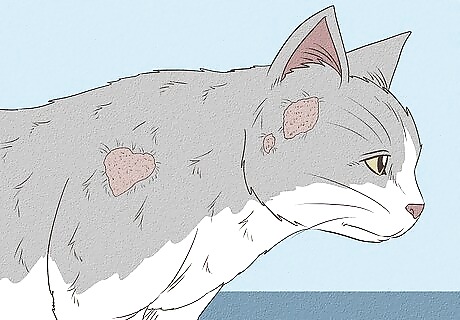
Look for patches of hair loss on your cat. The ringworm fungus grows around hair shafts and migrates downward into the hair follicles. This leads to inflammation and causes the hair to shed, leaving a patch of bald, flaky skin behind. These bald areas are often scaly or crusty, and may be reddened and inflamed. Typically, the areas are itchy and the cat may scratch or lick at them. Sometimes the areas of hair loss appear moist or sticky caused by a secondary bacterial infection as a result of inflammation or scratching. However, it can be difficult to find these lesions on long-haired cats.
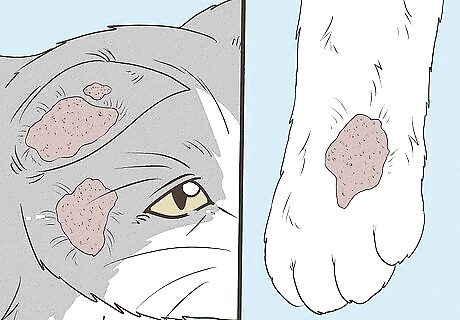
Identify any scaly patches on your cat's face, paws or ears. Classic places for infection are the cat's face, muzzle, ears, and front paws. The fur on the face may have a moth-eaten appearance, with mottled areas of fur loss. On the paws, infection is often around the nail bed, so individual toes may be bald with scaling skin around the nail. The distribution of lesions on the paws and face is because cats most commonly catch infection while investigating the environment: sniffing or pawing at things.
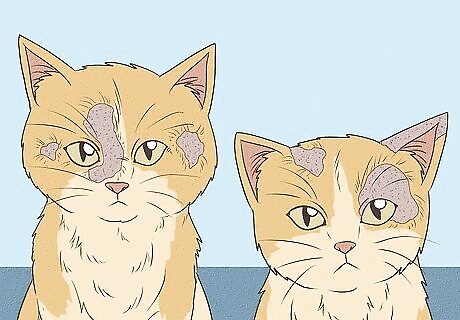
Watch out for signs of infection in multiple cats. Typically, cats living closely together, such as a litter of kittens in a rescue shelter, infect one another and several animals with itchy bald patches should raise an immediate suspicion of ringworm.

Keep an eye out for skin lesions on your own skin. Another sign of ringworm is if you – the cat's owner – develop skin lesions. In people these are typically itchy, raised red and inflamed patches of skin that are dry and scaly. These lesions are often circular and resemble a ring, or a pattern of rings. Sometimes the outer border is bumpy around a scaly center. Places that come into contact with the cat are most likely to be infected, thus your hands from stroking the cat, or your lap from holding her, are typical for infection.
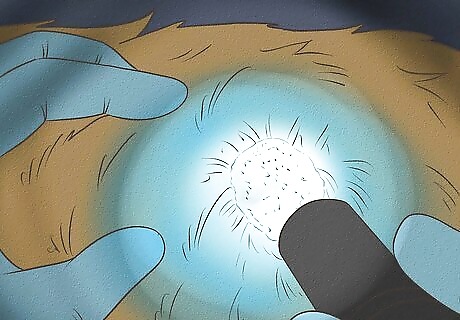
See a vet to confirm the presence of ringworm. If your cat shows signs of ringworm, or you have suspicious lesions on your own skin, get your cat checked by a veterinarian. Ringworm can mimic a number of conditions such as skin infections, allergic skin disease, and parasitic skin disease, therefore reaching a firm diagnosis involves examining plucked hairs under the microscope to look for fungal hyphae along the hair shaft. The vet may also check the cat under an ultraviolet light to look for the characteristic apple-green fluorescence given off by some ringworm species. The vet may also do a fungal culture, where the fungus is grown from sample coat brushings from the cat. These tests may take a few weeks to run because the fungus grows slowly.
Treating Ringworm
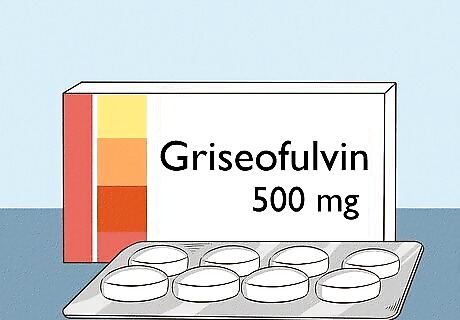
Put the cat on an anti-fungal medication. Griseofulvin is an anti-fungal medication, which stops the ringworm from growing rather than killing it. Griseofulvin acts by disrupting the fungi's cell division and preventing it from multiplying, thus putting it into an inactive state. The cat will need to be on this medication for several weeks. Griseofulvin is more effective if given with a fat, such as a knob of butter, because this enhances absorption into the blood stream. The suggested dose is 50mg/kg given once a day for up to 70 days (and for at least 2 weeks after the skin lesions have resolved). This is equivalent to a 5 kg cat taking half a 500mg tablet once a day. Griseofulvin should not be given to pregnant cats because it causes deformities in the kittens in the womb. Griseofulvin should not be handled by pregnant women. As a precaution, it is best to wear disposable gloves if cutting the tablets up. Although griseofulvin is not damaging to healthy people, it is sensible to avoid accidental ingestion. In rare cases, this medication can cause bone marrow suppression, which is a potentially life threatening condition.
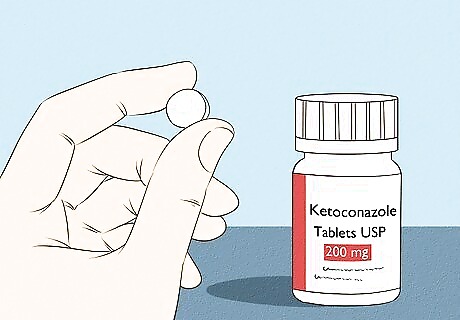
Give the cat an antifungal medication. Ketoconazole is an imidazole antifungal agent which acts by inhibiting the synthesis of the fungal cell walls, which makes it leaky and causes the cell's contents to leak out. The recommended dose is 5 to 10mg/kg by mouth, 2 or 3 times daily after food. Thus a 5 kg cat requires 25 to 50mg per dose. A 500mg/ 5ml oral suspension is available, which means an average-sized cat needs between 0.25 to 0.5ml by mouth, 2 or 3 times a day. Ketoconazole has a broader spectrum of activity than griseofulvin; as well as treating ringworm, it can be used to treat aspergillosis, candidiasis (thrush infection), cryptococcus, and coccidiomycosis infections (these are a variety of fungal or single celled organism that are sensitive to ketoconazole). As with griseofulvin, treatment is for lengthy period of time, and is often continued until 2 negative fungal cultures taken 3 weeks apart have been obtained.
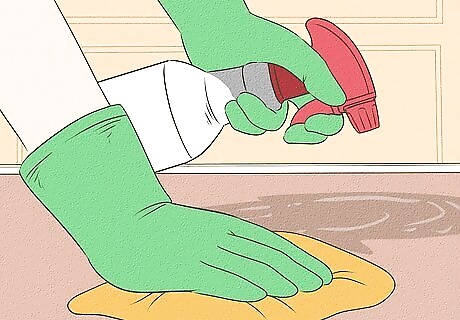
Implement environmental controls. While medical treatment is initiated and ongoing, it is important to decrease the amount of environmental contamination with fungal spores. This helps to ensure that once the cat is cleared of ringworm, she doesn't then re-infect herself, or that the environment does not act as a reservoir of infection for you, the owner. Keep the cat in one room. Everywhere the cat goes she sheds dander and hair, which are potential sources of ringworm infection. Ideally you should keep the pet confined to one room so as to minimize the spread of infection. Remove all the soft furnishings except for the cat's bed, since these are more difficult to clean. The cat's bed should be washed by itself, in a washing machine on a hot wash with detergent. (There is minimal risk of further washes being contaminated). Where possible, leave the bed to dry in bright sunshine. The room should be cleaned and disinfected with a 1:10 dilution of household bleach in water. This means that you add 100ml of bleach to each 900ml of water, to make up a stock cleaning solution. In an ideal world, all hard surfaces in the room would be cleaned with dilute bleach daily to minimize build-up of contamination. The room should also be vacuumed and the vacuum bag disposed of by incineration.
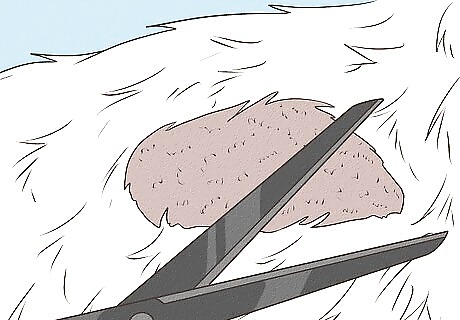
Clip the cat's coat. The ringworm fungus grows down hair shafts. To give ringworm less chance to colonize the cat's coat, and also ensure that there is less shedding of infected hairs, it is a good idea to clip the cat's coat short. This is best done with scissors (clippers can damage the skin and encourage fungal colonization) but it requires a co-operative cat. Keep the scissor blades parallel to the surface of the skin and cut at 90 degrees to the hair shafts. Trim away the hair as close to the skin as possible without cutting or nicking the skin. Wear a disposable plastic apron and gloves while clipping the cat, and throw these away afterwards. Collect the clippings in a plastic bag and dispose of by burning if possible. If this is not possible, double wrap them in another plastic bag and dispose of in the garbage. Throw away any grooming equipment used on the infected cat, or thoroughly disinfect it with dilute bleach. If the cat objects to being clipped then speak to your veterinary clinic who will be happy to sedate the animal and professionally clip him.

Shampoo the cat. Washing the cat with an appropriate shampoo can help clean the hair follicles, and reduce the shedding of infected hairs and dander. This should be done for both clipped and unclipped cats. Twice weekly shampooing for 6-10 weeks is recommended as a back up to antifungal medications. The shampooing is not so much to kill the fungus (although this is a bonus if a medicated shampoo is used) but to decrease environmental contamination. With this in mind, if a treatment shampoo is not available, any mild shampoo suitable for use on the cat is acceptable as an alternative.
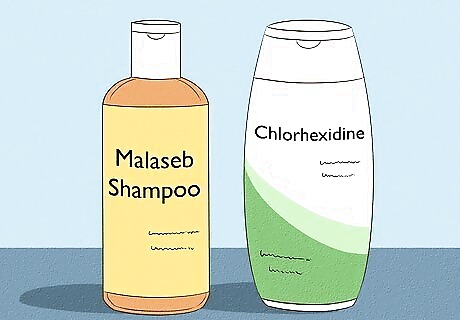
Find a suitable shampoo. If you choose to use a treatment shampoo, you should look for one of the following: Chlorhexidine: A suitable topical treatment is a solution of chlorhexidine. Chlorhexidine is an antiseptic with antifungal properties. This is diluted in water (an appropriate dilution is 5ml of chlorhexidine to 1 liter of water) and sponged over the cat and allowed to air dry. Malaseb shampoo: Malaseb shampoo contains 2% chlorhexidine plus 2% miconazole (an antifungal agent). Malaseb is used as a shampoo and so the coat and skin should be thoroughly wet, the shampoo lathered on and left in contact with the skin for 10 minutes, and then rinsed thoroughly. Enilconazole: Enilconazole is an antifungal agent that is applied externally to the skin and can be used on pregnant cats and young kittens. One part enilconazole is diluted in 50 parts of water to produce a 0.2% solution. This is then sponged over the cat every 3 days.
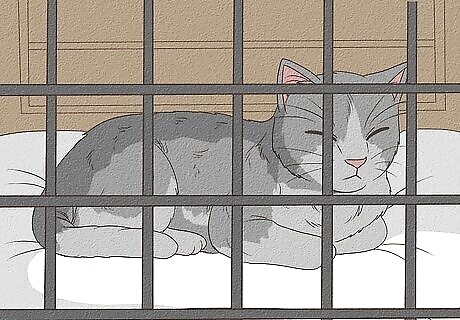
Understand the prognosis. Healthy cats can be expected to self-cure in around 2 to 3 months. During this time, however, they are a source of infection for others and so it is best to keep them in isolation. For those cats that show significant clinical signs (such as patchy hair loss, scaling, and itchiness), clearing that infection is a lengthy and time-consuming process that involves both oral medications and topical treatments.



















Comments
0 comment